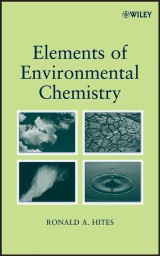Details

Elements of Environmental Chemistry
1. Aufl.
|
33,99 € |
|
| Verlag: | Wiley |
| Format: | |
| Veröffentl.: | 29.06.2007 |
| ISBN/EAN: | 9780470140444 |
| Sprache: | englisch |
| Anzahl Seiten: | 224 |
DRM-geschütztes eBook, Sie benötigen z.B. Adobe Digital Editions und eine Adobe ID zum Lesen.
Beschreibungen
The basics of environmental chemistry and a toolbox for solving problems<br /> <br /> Elements of Environmental Chemistry uses real-world examples to help readers master the quantitative aspects of environmental chemistry. Complex environmental issues are presented in simple terms to help readers grasp the basics and solve relevant problems. Topics covered include: steady- and non-steady-state modeling, chemical kinetics, stratospheric ozone, photochemical smog, the greenhouse effect, carbonate equilibria, the application of partition coefficients, pesticides, and toxic metals. Numerous sample problems help readers apply their skills. An interactive textbook for students, this is also a great refresher course for practitioners. <p>A solutions manual is available for Academic Adopters. Please click the solutions manual link on the top left side of this page to request the manual.</p>
<b>Chapter 1. Simple Tool Skills.</b> <p>1. 1. Unit Conversions.</p> <p>1. 2. Estimating.</p> <p>1. 3. Ideal Gas Law.</p> <p>1. 4. Stoichiometry.</p> <p>1. 5. Problem Set.</p> <p><b>Chapter 2. Mass Balance.</b></p> <p>2. 1. Steady-State Mass Balance.</p> <p>2. 1. 1. Flows, Stocks, and Residence Times.</p> <p>2. 1. 2. Adding Multiple Flows.</p> <p>2. 1. 3. Fluxes are Not Flows!</p> <p>2. 2. Non-Steady-State Mass Balance.</p> <p>2. 2. 1. Up-Going Curve.</p> <p>2. 2. 2. Down-Going Curve.</p> <p>2. 2. 3. Working with Real Data.</p> <p>2. 2. 4. Second Order Reactions.</p> <p>2. 3. Problem Set.</p> <p><b>Chapter 3. Atmospheric Chemistry.</b></p> <p>3. 1. Light.</p> <p>3. 2. Atmospheric Structure.</p> <p>3. 3. Ozone.</p> <p>3. 3. 1. Introduction to Ozone.</p> <p>3. 3. 2. The NO/NO2 Pathway.</p> <p>3. 3. 2. The OH/OOH Pathway.</p> <p>3. 3. 3. The Cl/OCl Pathway.</p> <p>3. 4. Chemical Kinetics.</p> <p>3. 4. 1. Pseudo Steady State Example.</p> <p>3. 4. 2. Arrhenius Equation.</p> <p>3. 4. 3. Chapman Reaction Kinetics.</p> <p>3. 5. Smog.</p> <p>3. 6. Greenhouse Effect.</p> <p>3. 7. Problem Set.</p> <p><b>Chapter 4. CO2 Equilibria.</b></p> <p>4. 1. Pure Rain.</p> <p>4. 2. Polluted Rain.</p> <p>4. 3. Surface Water.</p> <p>4. 4. Problem Set .</p> <p><b>Chapter 5. Fates of Organic Compounds.</b></p> <p>5. 1. Vapor Pressure.</p> <p>5. 2. Water Solubility.</p> <p>5. 3. Henry’s Law Constant.</p> <p>5. 4. Partition Coefficients.</p> <p>5. 5. Lipophilicity.</p> <p>5. 6. Fish Partition Coefficients.</p> <p>5. 7. Adsorption.</p> <p>5. 8. Water-Air Transfer.</p> <p>5. 9. Problem Set.</p> <p><b>Chapter 6. Toxic Environmental Compounds.</b></p> <p>6. 1. Pesticides.</p> <p>6. 1. 1. Diphenylmethane Analogues.</p> <p>6. 1. 2. Hexachlorocyclohexanes.</p> <p>6. 1. 3. Hexachlorocyclopentadienes.</p> <p>6. 1. 4. Phosphorous Containing Insecticides.</p> <p>6. 1. 4. 1. Phosphates.</p> <p>6. 1. 4. 2. Phosphorothioates.</p> <p>6. 1. 4. 3. Phosphorodithioates.</p> <p>6. 1. 5. Carbamates .</p> <p>6. 1. 6. Natural Product Simulants.</p> <p>6. 1. 7. Phenoxyacetic Acids.</p> <p>6. 1. 8. Nitroanilines.</p> <p>6. 1. 9. Triazines.</p> <p>6. 1. 10. Acetanilides.</p> <p>6. 1. 11. Fungicides.</p> <p>6. 2. Mercury.</p> <p>6. 3. Lead.</p> <p>6. 4. Problem Set.</p> <p>Answers to the problem sets.</p> <p>Index.</p>
"The work is very suitable for use as a textbook of environmental chemistry…" (<i>Angewandte Chemie</i>, 2008-47/14) <p>"A stand-alone text aimed at upper-level undergraduate chemistry or chemical engineering majors or at first-year graduate students." (<i>International Journal of Environmental and Analytical Chemistry</i>, March 2008)</p> <p>"...a pleasure to review this shrot volume which treats the subject of environmental chemistry in an appropriate manor as an essentially quantitative discipline." (<i>Chemistry World</i>, November 2007)</p> <p>"[This book] can be recommended to university lecturers."(<i>Angewandte Chemie International Edition</i>, 2008)</p>
<b>Ronald A. Hites</b>, PhD, is a Distinguished Professor at Indiana University Bloomington, where he is a senior faculty member of the School of Public and Environmental Affairs. A past president of the American Society for Mass Spectrometry, Dr. Hites is an Associate Editor of thejournal of Environmental Science and Technology and a winner of the American Chemical Society's Award for Creative Advances in Environmental Science and Technology and of the Society of Environmental Toxicology and Chemistry's Founders Award.
<p>The basics of environmental chemistry and a toolbox for solving problems</p> <p>Elements of Environmental Chemistry uses real-world examples to help readers master the quantitative aspects of environmental chemistry. Complex environmental issues are presented in simple terms to help readers grasp the basics and solve relevant problems. Topics covered include: steady- and non-steady-state modeling, chemical kinetics, stratospheric ozone, photochemical smog, the greenhouse effect, carbonate equilibria, the application of partition coefficients, pesticides, and toxic metals. Numerous sample problems help readers apply their skills. An interactive textbook for students, this is also a great refresher course for practitioners.</p>


















